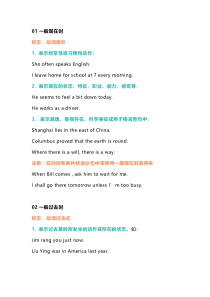 DOC
DOC
【文档说明】初中英语8个时态的奥秘.docx,共(10)页,20.086 KB,由小魏子文库上传
转载请保留链接:https://www.ichengzhen.cn/view-250193.html
以下为本文档部分文字说明:
01一般现在时标志:动词原形1.表示经常性或习惯性动作:SheoftenspeaksEnglish.Ileavehomeforschoolat7everymorning.2.表示现在的状态、特征、职业、能力、感觉等:Heseemstofeelabitdowntoday.Heworksasadriv
er.3.表示真理、客观存在、科学事实或用于格言警句中:ShanghailiesintheeastofChina.Columbusprovedthattheearthisround.Wherethereisawill,thereisaway.注意:在时间和条件状语从句中常使
用一般现在时表将来WhenBillcomes,askhimtowaitforme.IshallgotheretomorrowunlessI’mtoobusy.02一般过去时标志:动词过去式1.表示过去某时所发生的动作或存在的状态,如:
Jimrangyoujustnow.LiuYingwasinAmericalastyear.2.表示过去经常或反复发生的动作,特别是usedtodo表达的句型,本身表示的就是过去常常。如:WhenIwasakid,Ioftenplayedfootballinthestreet.S
heusedtovisithermotheronceaweek.*注意区分sb.usedtodosth.(某人过去常常做某事,此处to是动词不定式标志符号)和sb.beusedtosth./doingsth.(某人习惯于某物/做某事,此处to
是介词)。3.代替一般现在时,表示一种婉转、客气、礼貌、商量的语气。此用法仅适用于少数动词(如want,hope,wonder,think,intend等)及情态动词could,would。如:Iwo
nderedifyoucouldhaveawordwithme.IhopedyoucouldhelpmewithmyEnglish.Wouldyoumindmysittinghere?03一般将来时标志:will/shall+动词原形1.表示将来发生的动作或存在的
状态,如:Weshallhavealotofrainnextmonth.Myhusbandwillcomebackinafewdays.2.表示倾向性和习惯性:Fishwilldiewithoutwater.Whe
nitgetswarmer,thesnowwillstarttomelt.3.一般将来时的几种句式结构辨析:1)will/shall+动词原形多用于表达主观愿望或必定会发生的事情(“将会如何”)*shall作助动词时一般只用于第一人称2)beg
oingto+动词原形表示即将发生或打算要做的事:Itisgoingtorain.Wearegoingtohaveameetingtoday.3)beto+动词原形表示按计划或安排即将要发生的动作:Heistov
isitJapannextyear.WearetodiscussthereportonMonday.4)beaboutto+动词原形表示即将发生的动作,意为“马上要做某事”,后面一般不跟时间状语,如:Theplaneisabouttostart.Don’tworry.Iama
bouttomakeacloseexaminationonyou.04现在进行时标志:be+动词的现在分词1.表示说话时正在进行的动作:Sheiswritingaletterupstairs.Whoarey
ouwaitingfor?Itisraininghard.2.表示现阶段一直在进行的动作(说话时动作未必正在进行):IhearMr.Greeniswritinganothernovel.3.表示反复出现或习惯性的
动作,往往包含说话者赞扬、责备、厌恶等情绪,通常与always,constantly,continually,forever等频度副词连用。如:Johnisforeveraskingsillyquestionslikea
stupid.Heisalwaysthinkingofothersfirst.4.表示将来1)表示按计划、安排将要发生的动作,仅适用于部分趋向动词(如go,come,leave,start,arrive等)。如:UncleWangiscoming.Th
ey'releavingforBeijing.2)在时间和条件状语从句中,现在进行时表示将来某时正在发生的事情。如:Pleasedropinwhenyouarepassingmyway.Ifheisstillsleeping,don’twakeh
imup.05过去进行时标志:was/were+动词的现在分词1.表示过去某一时刻或一段时间正在进行的动作,如:IwashavingatalkwithLucyatthattime.TheywerewatchingTVathomelastnight.2.表示过去反复
出现或习惯性的动作,往往包含说话者赞扬、责备、厌恶等情绪如:Mybrotherwasalwayslosinghiskeys.3.表示按计划、安排过去某时刻将要发生的动作,仅适用于部分趋向动词(如go,c
ome,leave,start,arrive等)。如:HesaidtheywereleavingforBeijingthisafternoon.4.过去进行时有一个主要用法就是描述一件事情发生的背景(一个长动作延续的时候,另一个短动作发生):Grannyf
ellasleepwhenshewasreading.Itwasrainingwhentheyleftthestation.06现在完成时标志:have/has+动词的过去分词1.表示一个过去发生并已完成的动作对现在产生影响或结果,强调的是现
在的状况(表示“已完成”)。如:Hehasleftthecity.(结果:他目前不在这个城市)Someonehasbrokenthewindow.(结果:窗户破了)2.表示一个动作开始于过去,持续到现在,也可能还会继续持续下去(表示“未完成”)。Ihavebeenbu
sysincelastweek.Hehastaughtinourschoolfor30years.I’vefinishedhalfsofar.注意:瞬间动词通常是不能用现在完成时表持续性的,但其否定结构则可以。如:Shehasn’tseenyouforages.Hisfatherhasn’tt
ouchedbeerforawholeweek.3.表示过去到现在为止反复发生的动作或多次出现的状态,常与表示频度的副词always,often,everyday等连用。如:Ihaveoftenheardthatheisthecleverestpersoninthatcompany.4.
在时间和条件状语从句中,现在完成时表示将来某时完成的动作。如:I’llgotoyourhomewhenIhavefinishedmyhomework.Ifithasstoppedsnowinginthemorning,we’llgo
thepark.5.与现在完成时连用的常见词语能与现在完成时连用的词语很多,just,already,yet,before,never,ever,recently等,但常见的有:1)since自从Ihavebeentheremanytimessincethewar.
Wehaven’tseeneachothersincelastweek.Wehavebeenfriendseversince.2)in/for/duringthepast/last…years在过去/最近…中I’veb
eenillforthepastthreeweeks.Greatchangeshavetakeplaceinthelasttenyears.Ihavebeenhere(for)thelast/pastmonth.3)sofar到目前为止Wehaven’thadanytroublesofa
r.Sofarthesearchforthemissingmiddle-agedwomanhasbeenfruitless.4)upto/untilnow到现在为止Uptonowhe’sbeenquiet.Uptonow,theworkhasbeeneasy.Ihave
heardnothingfromhimuptillnow.Uptillnowwehaveplantedover2000trees.5)Itis/willbethefirst/second…timethat…这是
第一/二…次…It’sthefirsttime(that)I’vebeenhere.Itwillbethefirsttime(that)I’vespokeninpublic.Itisthesecondtime(that)Ihave
methimtoday.6)Thisis+形容词最高级+that…这是最…ThisisthebestfilmthatI’ve(ever)seen.6.现在完成时与一般过去时的区别1)现在完成时强调对现在的影响和结果,与现在有联系;而一般过去时强调这个动作发生的时
间是在过去,不涉及对现在的影响。如:Ihaveseenthisfilm.(我已经看过了这部电影)Isawthisfilmyesterday.(我是昨天看的这部电影)2)现在完成时常与模糊的时间状语连用(如for,sin
ce,sofar,ever,never,just,yet,till/until,uptonow,always等),或者干脆没有时间状语;而一般过去时常与具体的时间状语连用(如yesterday,lastnight,…a
go,in1980,inFebruary等)。3)现在完成时表示持续时一般使用延续性动词(如live,teach,work,know等);而一般过去时常使用瞬间动词(如begin,buy,die,marry等)。如:Hehas
livedinHangzhousincelastspring.Mygrandfatherboughtthecarfiveyearsago.7.易错点辨析1)考生容易把一些瞬间动词用现在完成时表达,这是错误的。如:(×)H
ehasdiedfortwoyears.他死了两年了。(√)Hehasbeendeadfortwoyears.(√)Hediedtwoyearsago.(×)Thefilmhasbegunfor10minutes.电
影开演十分钟了。(√)Thefilmhasbeenonfor10minutes.(√)Thefilmbegan10minutesago.(×)Shehasmarriedforthreeyears.她结婚有三年了。(√)Shehasbeenmarriedfo
rthreeyears.(√)ShemarriedMikethreeyearsago.2)考生不懂如何区分havebeento和havegoneto,尽管两者均可后接地点,但havebeento表示去过某地(现在已经回来了),havegoneto表示到某地去了(现在还没回来)。如:Shehasb
eentoParis(threetimes).ShehasgonetoParis.07过去完成时标志:had+动词的过去分词1.表示在过去的某个时间或动作以前已经发生的动作或已经存在的状态。如:Bythe
endoflastweekhehadfinishedthework.HehadleftwhenIarrived.2.表示从过去某一时间开始,一直延续到过去另一时间的动作或状态。如:Wehadnotseene
achothersinceIleftBeijing.Thefilmhadbeenonfor5minuteswhenIgottothecinema.3.某些表意向的动词(如intend,think,plan,ex
pect,hope等)的过去完成时表示主语未曾实现的愿望、希望、打算。如:Ihadintendedtovisityoulastnight,butsomeonecalledandIcouldn’tgetaway.Wehadhopedthatyouwo
uldcome,butyoudidn’t.4.过去完成时与一般过去时1)基本区别:过去完成时表示以过去某时间为起点以前所发生的动作或存在的状态,即过去完成时强调“过去的过去”,而一般过去时只表示以现在时间为起点以前所发生的事情或存
在的状态。如:Hestudiedtheretwoyearsago.他两年前在那儿学习(离现在两年)Hesaidhehadstudiedtheretwoyearsbefore.他说他两年前在那儿学习过。(离他说话时两年)2)特
别注意:两个动作如果按顺序发生,又不强调先后,或者用then,and,but等连词连接时,多用一般过去时。如:Whenshesawthemouse,shescreamed.MyauntgavemeahatandIlostit.08过去将来时标志:would+动词原
形1.表示从过去某一时间来看将要发生的动作或存在的状态,一般用于主句为过去时的宾语从句中。如:HesaidhewouldcomeherenextFriday.Iknewthathewouldhelpuswhenwewereintro
uble.2.表示过去的动作习惯或倾向:Theoldmanwouldsitonabenchinthequiteparkforhourswithoutdoinganything.WhenIworkedonthatfarm,I
wouldgetupat5am.
 辽公网安备 21102102000191号
辽公网安备 21102102000191号
 营业执照
营业执照